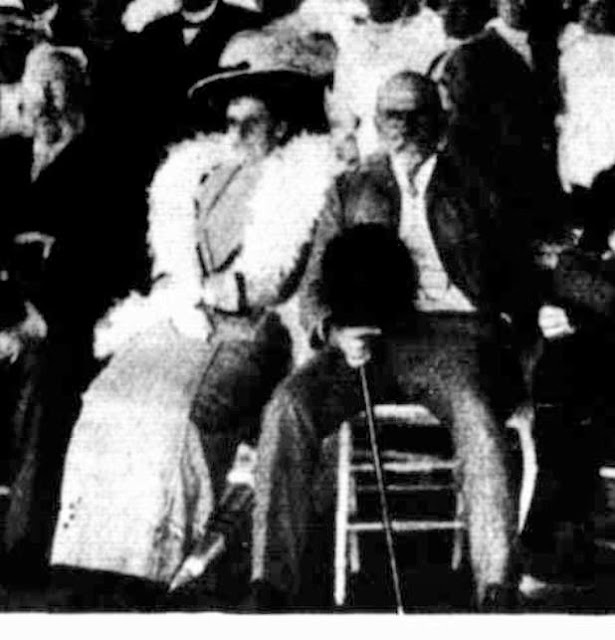The Albert Park Lake Kiosk was officially opened on December 9, 1911 by the Mayor of South Melbourne, Cr Donald McArthur. His speech was reported in The Age - The kiosk was an ornamental and imposing structure, and it would add to the improvement and beautification of the park, which, with its area of 600 acres, gave breathing space to the the residents of the city and suburbs.... The park was a national park, open to everyone in and around Melbourne (1).
Also present were other South Melbourne Councillors, Councillors from St Kilda and other officials such as Henry Allen, Secretary of the Albert Park Committee and Carlo Catani. The Kiosk, later renamed the Chalet Geneve, was operated by Rosana Savary and her sisters, Frances and Katherine Mathieu. I have written in detail about the Chalet and the Mathieu sisters and their operation of the Chalet Geneve as well as the ones in the Fitzroy Gardens and Central Park, Malvern in another blog post, here (2).
This post is about the role Carlo played in establishing the Albert Park Lake Kiosk and his reported speech on the day. We (3) have also found a photo of Carlo and a very rare photo of his wife, Catherine, at the opening ceremony, which you will see below.
The refreshment kiosk at Albert Park Lake was one part of grander plans for the Park proposed by the Albert Park Committee or Trust. In 1907, there were newspaper reports that £10,000 would be spent beautifying the park and that a scheme be prepared by Mr. Catani, engineer of the Public Works department, and the engineers of the two councils for consideration (4). Nothing came of this, but two years later the South Melbourne Council proposed a £20,000 scheme for improving Albert Park. It was suggested that once again Mr Catani should prepare a comprehensive scheme for the improvement of the park (5). However, in the end the Council decided that they should call for competitive designs for the park and the winning designer would receive £50 (6). As the money for this scheme was not forthcoming it did not go ahead, however the Albert Park Committee, of which Carlo Catani was a member, proceeded with the idea of building a kiosk (7).
Carlo was invited to speak at the opening and his speech was reported in the Prahran Telegraph thus - Mr C.Catani, C. E., said that to improve the park £25,000 would be required - as a beginning. They would have to begin by making a promontory to take off the flat look and to show the landscape. They required to raise the ground, and they wanted to get rid of the
Tips to the right of us,
Tips to the left of us,
Cows all around us.
They wanted the Government to give them a big waggon to bring plenty of good soil, so as to raise the level of the ground by two feet, and they wanted to plant trees properly. That would take money. It was up to the Trust to raise £25,000, and he would undertake that it was spent properly (8).
The report of the opening in the Prahran Telegraph had the heading - Albert Park Tea Kiosk. Official Opening. 'The Cow Ranch' (9). The Albert Park Committee allowed the agistment of cattle and other livestock in Albert Park, because it was a source of income. In 1907 it was reported that there were 129 horses, 210 cows and 43 calves in the Park (10). At the opening of the Kiosk in December 1911, Cr Baragwanath of South Melbourne said the Trust had been doing a good bit of work up to date, but he would not be satisfied until the cows and horses were out of what he called the Cow Ranch (11). Cr O'Donnell of St Kilda, responded to this the Trust had done its level best to improve the park, but he didn't know about getting rid of the cows which Cr Baragawanath talked of. The cows gave them an income of £600 a year, which enabled the Trust to improve the park (12).
One of the tips which Carlo referrred, was still there in 1930. The burning off in the tip was apparently a source of distress to the thousands of people who attended the football at the Park, even though Miss Fitzpatrick, who was then the owner of the Chalet had no complaints (13).
This post is a brief look at the role Carlo played in the development and opening of the Albert Park Chalet. The guests at the ceremony are pictured above. Seated at the first table on the left is the Mayor of South Melbourne, Cr Donald McArthur. Next to him is Henry Allen, then the dignified woman with the fur stole is Catherine Catani and next to her is Carlo. I have never seen a photo of Catherine before, so even though it is very grainy, it is gold.
Acknowledgement
Trove - I created a list connected to the Albert Park Chalet and the two other refreshment kiosks operated by the Mathieu sisters - one in the Fitzroy Gardens and the other at Central Park, Malvern. Access it here.
Footnotes(1) The Age, December 11, 1911, see here.
(2) https://victoriaspast.blogspot.com/2021/04/the-chalet-geneve-on-albert-park-lake.html
(3) I say we, but it was actually, Isaac. See the Acknowledgment.
(4) Emerald Hill Record, June 8, 1907, see here.







